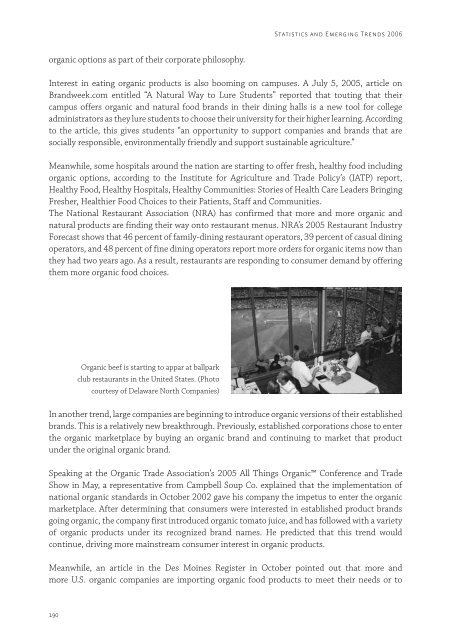the world of organic agriculture - Organic Eprints
the world of organic agriculture - Organic Eprints
the world of organic agriculture - Organic Eprints
Create successful ePaper yourself
Turn your PDF publications into a flip-book with our unique Google optimized e-Paper software.
<strong>organic</strong> options as part <strong>of</strong> <strong>the</strong>ir corporate philosophy.<br />
190<br />
Statistics and Emerging Trends 2006<br />
Interest in eating <strong>organic</strong> products is also booming on campuses. A July 5, 2005, article on<br />
Brandweek.com entitled “A Natural Way to Lure Students” reported that touting that <strong>the</strong>ir<br />
campus <strong>of</strong>fers <strong>organic</strong> and natural food brands in <strong>the</strong>ir dining halls is a new tool for college<br />
administrators as <strong>the</strong>y lure students to choose <strong>the</strong>ir university for <strong>the</strong>ir higher learning. According<br />
to <strong>the</strong> article, this gives students “an opportunity to support companies and brands that are<br />
socially responsible, environmentally friendly and support sustainable <strong>agriculture</strong>.”<br />
Meanwhile, some hospitals around <strong>the</strong> nation are starting to <strong>of</strong>fer fresh, healthy food including<br />
<strong>organic</strong> options, according to <strong>the</strong> Institute for Agriculture and Trade Policy’s (IATP) report,<br />
Healthy Food, Healthy Hospitals, Healthy Communities: Stories <strong>of</strong> Health Care Leaders Bringing<br />
Fresher, Healthier Food Choices to <strong>the</strong>ir Patients, Staff and Communities.<br />
The National Restaurant Association (NRA) has confirmed that more and more <strong>organic</strong> and<br />
natural products are finding <strong>the</strong>ir way onto restaurant menus. NRA’s 2005 Restaurant Industry<br />
Forecast shows that 46 percent <strong>of</strong> family-dining restaurant operators, 39 percent <strong>of</strong> casual dining<br />
operators, and 48 percent <strong>of</strong> fine dining operators report more orders for <strong>organic</strong> items now than<br />
<strong>the</strong>y had two years ago. As a result, restaurants are responding to consumer demand by <strong>of</strong>fering<br />
<strong>the</strong>m more <strong>organic</strong> food choices.<br />
<strong>Organic</strong> beef is starting to appar at ballpark<br />
club restaurants in <strong>the</strong> United States. (Photo<br />
courtesy <strong>of</strong> Delaware North Companies)<br />
In ano<strong>the</strong>r trend, large companies are beginning to introduce <strong>organic</strong> versions <strong>of</strong> <strong>the</strong>ir established<br />
brands. This is a relatively new breakthrough. Previously, established corporations chose to enter<br />
<strong>the</strong> <strong>organic</strong> marketplace by buying an <strong>organic</strong> brand and continuing to market that product<br />
under <strong>the</strong> original <strong>organic</strong> brand.<br />
Speaking at <strong>the</strong> <strong>Organic</strong> Trade Association’s 2005 All Things <strong>Organic</strong> Conference and Trade<br />
Show in May, a representative from Campbell Soup Co. explained that <strong>the</strong> implementation <strong>of</strong><br />
national <strong>organic</strong> standards in October 2002 gave his company <strong>the</strong> impetus to enter <strong>the</strong> <strong>organic</strong><br />
marketplace. After determining that consumers were interested in established product brands<br />
going <strong>organic</strong>, <strong>the</strong> company first introduced <strong>organic</strong> tomato juice, and has followed with a variety<br />
<strong>of</strong> <strong>organic</strong> products under its recognized brand names. He predicted that this trend would<br />
continue, driving more mainstream consumer interest in <strong>organic</strong> products.<br />
Meanwhile, an article in <strong>the</strong> Des Moines Register in October pointed out that more and<br />
more U.S. <strong>organic</strong> companies are importing <strong>organic</strong> food products to meet <strong>the</strong>ir needs or to
















